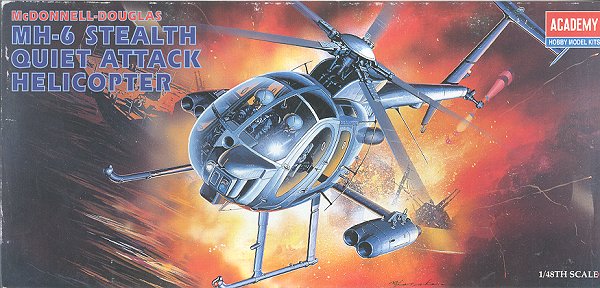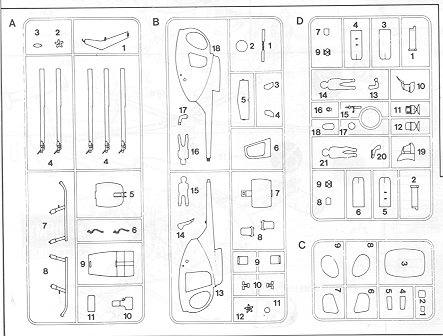
|
KIT: |
Academy 1/48 MH-6 |
|
KIT # |
1691 |
|
PRICE: |
$8.00 |
|
DECALS: |
None (!) |
|
REVIEWER: |
|
|
NOTES: |

|
HISTORY |
Developed from the OH-6 of the mid 1960s, the MH-6 is based on the MD500 series of small helicopters that have proven to be so successful with both civil and military operators. The MH-6 is basically a special ops helo. Its purpose is to help carry out covert operations. Much of this is due to the special Radar Absorbent Material (RAM) in its paint. This RAM is quite similar to that which coats the F-117 and B-2 Stealth aircraft. It allows the MH-6 to get closer to its quarry before being sighted by enemy radar (how they mask those spinning rotor blades is something that must be most difficult).
As a result, the MH-6 is generally a pretty boring aircraft to look at. Basically black with no other external markings. The MH-6 is also capable of carrying just about any weapon that any other chopper can handle, making it most useful for a variety of missions. This particular kit is based on the prototype which was first shown at the Edwards AFB open house in 1988.
|
THE KIT |

In carrying out the stealth format, all of the non-clear plastic bits are molded in black. As such, taking a picture of the sprues would be an exercise in futility, so I've scanned the parts breakdown in the instruction sheet instead. There is a separate sprue for the weapons and various sensors that the helo carries. This extra sprue also includes two crew members that look a bit more military than those with the rest of the kit. There is little in the way of surface detail on this helo and what is there is nicely engraved. As you know, I go on about Academy's reverse engineering. Well, I know darn little about this particular kit, but do know that both Fujimi and Italeri do this version in 1/48 so which was used as a pattern is unknown.
If you do the kit as boxed, then there are no options. As with a lot of chopper kits, there is no collective and only a cyclic control. I'm not really sure why this is left out so often. There are various sensors to attach as well as the rocket launchers on the end of small winglets. What you won't use is the mast mounted sensor that is used on other kits based on this version. The clear bits are really a sort of yellowish tint that I guess is supposed to be that thin gold plating that is used to prevent problems from electronic jamming. The instructions state that the rear windows are to be painted an opaque flat black. There is a single decal for the instrument panel.
|
CONCLUSIONS |
It looks to me to be a very nice kit, despite not having any collective. Even beginners should not have too much trouble with the kit although the number and size of the clear bits may provide some concern.
Review kit courtesy of my kit collection.
If you would like your product reviewed fairly and fairly quickly by a site that has well over 100,000 visitors a month, please contact me or see other details in the Note to Contributors.